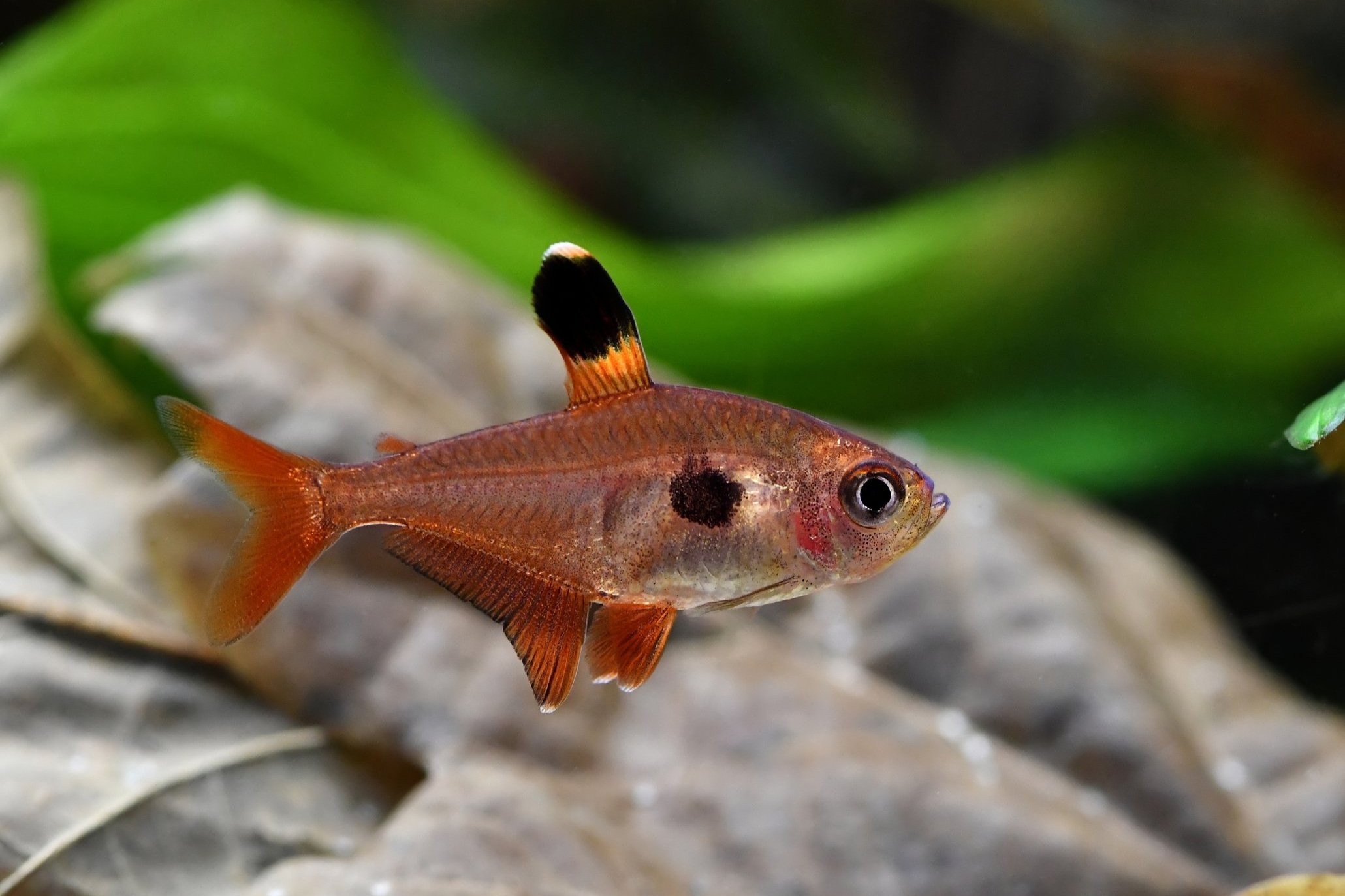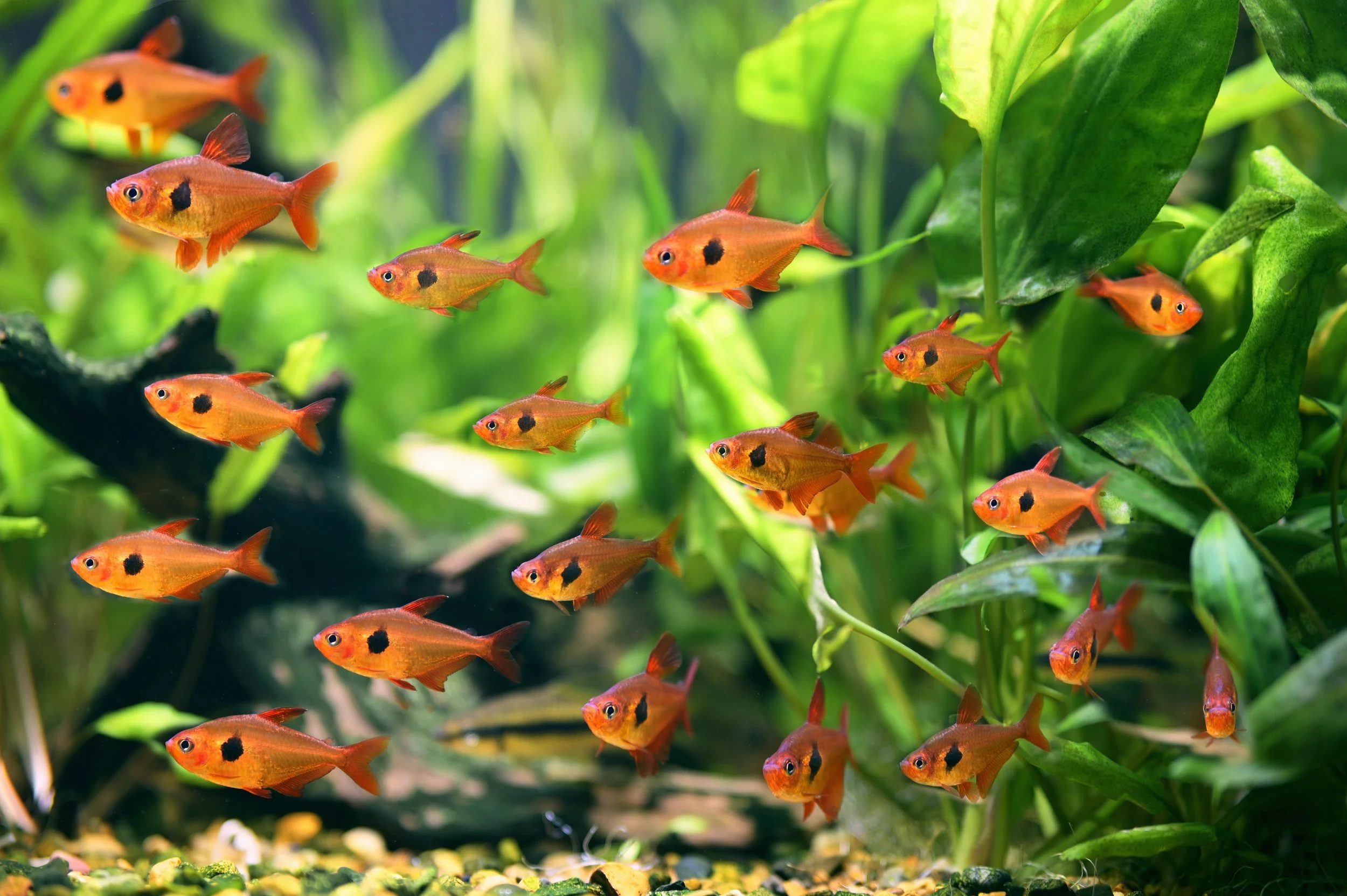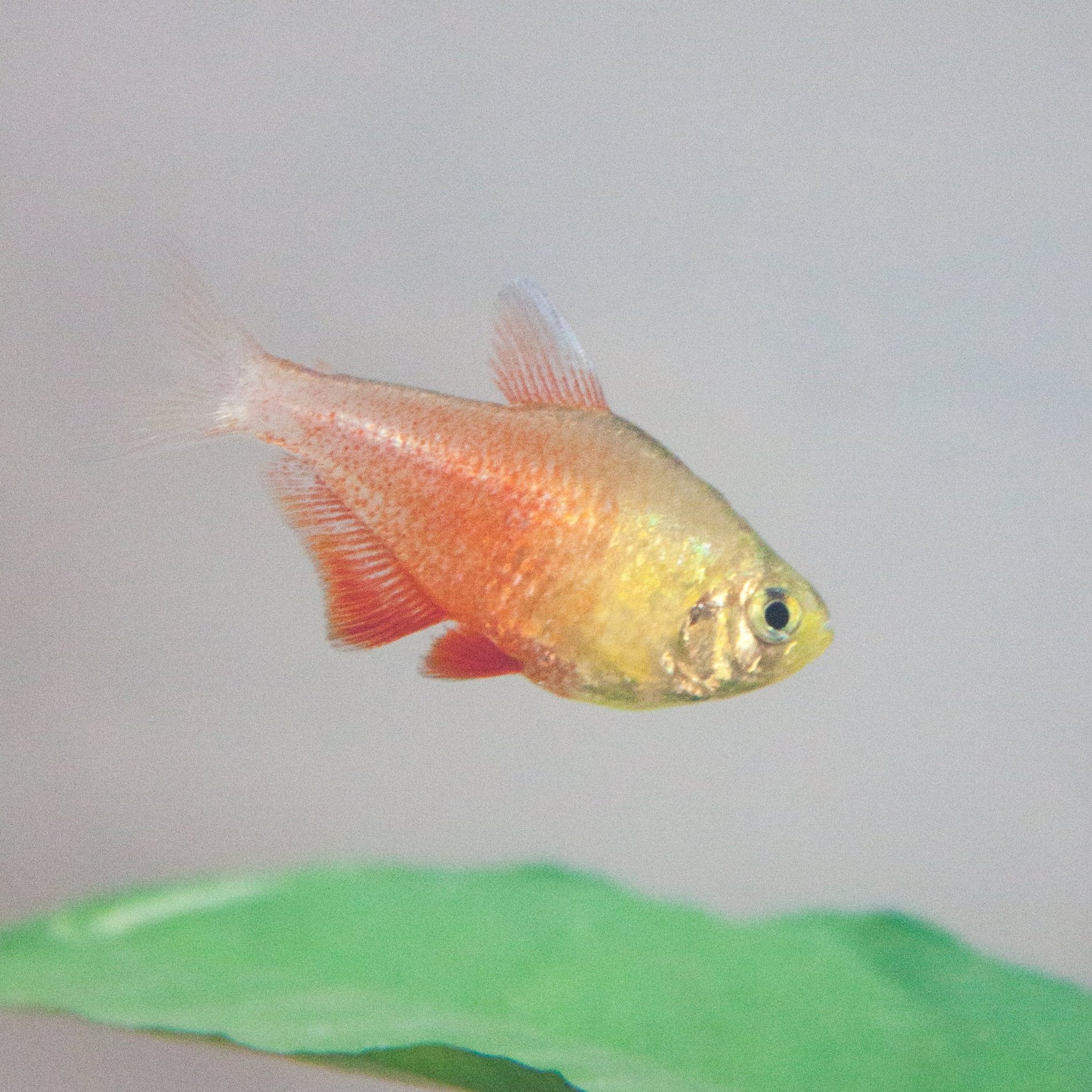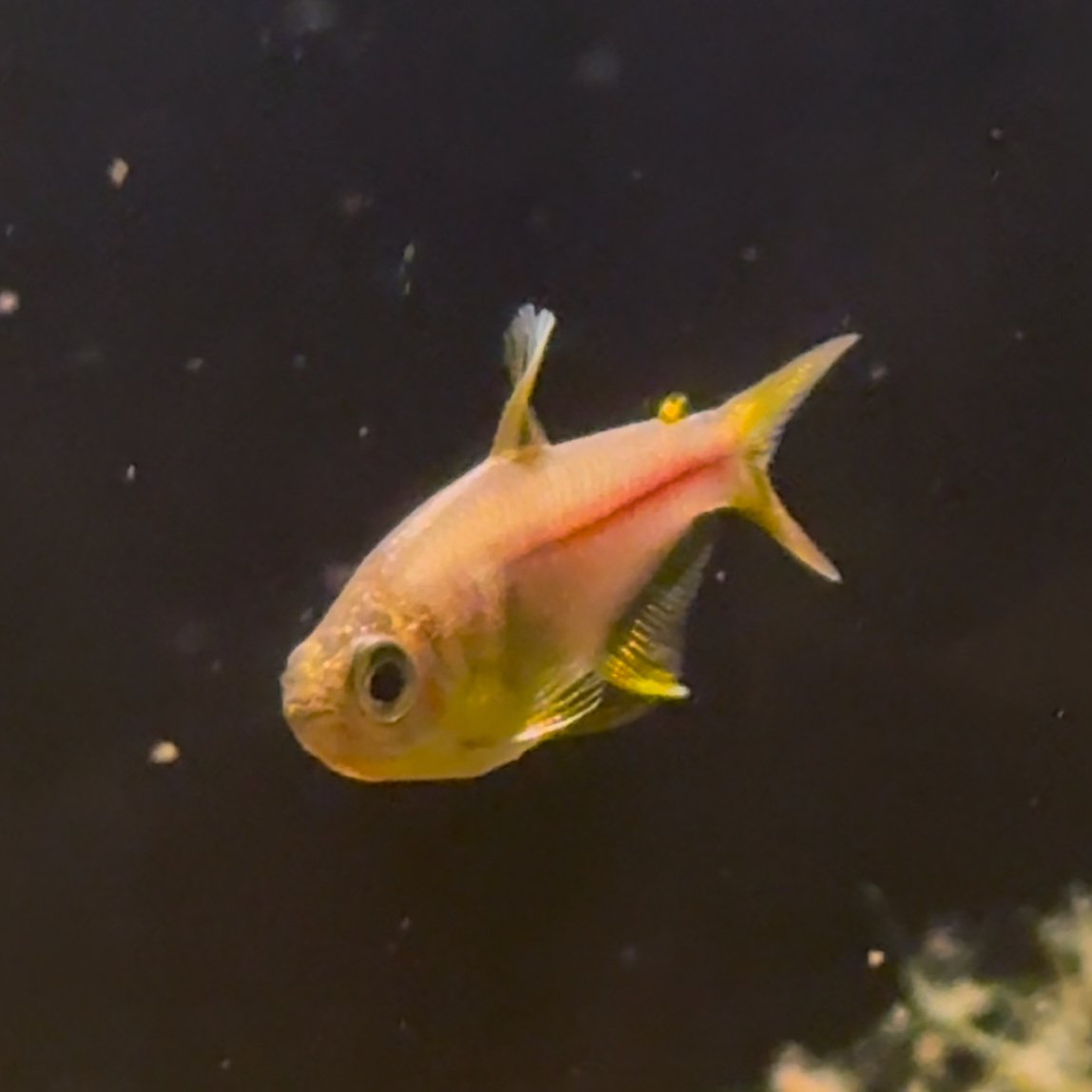 Image 1 of 2
Image 1 of 2

 Image 2 of 2
Image 2 of 2



Red Phantom Tetra
The Red Phantom Tetra, scientifically known as Hyphessobrycon sweglesi, is a small and vibrant freshwater fish native to the slow-moving rivers and streams of Colombia and Venezuela, particularly in the Orinoco River Basin. Renowned for its striking red coloration and peaceful schooling behavior, this species is a favorite among aquarists seeking a colorful addition to their community aquariums.
Physically, the Red Phantom Tetra features a laterally compressed, deep-bodied shape with a rich red hue that intensifies under good lighting. A characteristic black marking, often teardrop-shaped, is located behind the gill covers, and its fins are tipped with black, adding to its distinct appearance. Males are slightly slimmer and display brighter colors, while females are rounder and may exhibit less intense red. Adults typically grow to about 1.5 to 2 inches (3.8 to 5 centimeters) in length.
In the aquarium, Red Phantom Tetras thrive in groups of six or more, as their schooling behavior promotes natural activity and reduces stress. A tank of at least 20 gallons is recommended for a small group. The tank should include a soft, sandy substrate, live plants, and driftwood to provide shaded areas and mimic their natural environment. Floating plants can help diffuse light and make them feel more secure.
Water parameters for Red Phantom Tetras should replicate their natural habitat. They prefer soft, slightly acidic water with a pH range of 5.5 to 7.0 and temperatures between 72 to 79°F (22 to 26°C). Regular water changes and efficient filtration are essential to maintain clean, oxygen-rich water.
Feeding Red Phantom Tetras is straightforward, as they are omnivorous and readily accept a variety of foods. High-quality flakes or micro-pellets serve as a staple diet, supplemented with live or frozen foods such as brine shrimp, daphnia, and bloodworms. A varied diet helps enhance their coloration and overall health.
Red Phantom Tetras are peaceful and make excellent tank mates for other small, non-aggressive fish, such as rasboras, Corydoras, and other tetras. They are also compatible with dwarf cichlids and small gouramis. Avoid housing them with large or aggressive species that may intimidate or prey on them.
Breeding Red Phantom Tetras in captivity is achievable with proper care. They are egg scatterers, and spawning can be encouraged by providing soft, slightly acidic water and a breeding tank with fine-leaved plants or spawning mops. After spawning, the adults should be removed to protect the eggs. The eggs hatch within 24 to 36 hours, and the fry become free-swimming after about 3 to 4 days. Fry can be fed infusoria or powdered fry food, transitioning to baby brine shrimp as they grow.
Overall, the Red Phantom Tetra (Hyphessobrycon sweglesi) is a stunning and adaptable species that brings color and energy to freshwater aquariums. Their manageable size, peaceful temperament, and captivating appearance make them a great choice for aquarists of all levels.
The Red Phantom Tetra, scientifically known as Hyphessobrycon sweglesi, is a small and vibrant freshwater fish native to the slow-moving rivers and streams of Colombia and Venezuela, particularly in the Orinoco River Basin. Renowned for its striking red coloration and peaceful schooling behavior, this species is a favorite among aquarists seeking a colorful addition to their community aquariums.
Physically, the Red Phantom Tetra features a laterally compressed, deep-bodied shape with a rich red hue that intensifies under good lighting. A characteristic black marking, often teardrop-shaped, is located behind the gill covers, and its fins are tipped with black, adding to its distinct appearance. Males are slightly slimmer and display brighter colors, while females are rounder and may exhibit less intense red. Adults typically grow to about 1.5 to 2 inches (3.8 to 5 centimeters) in length.
In the aquarium, Red Phantom Tetras thrive in groups of six or more, as their schooling behavior promotes natural activity and reduces stress. A tank of at least 20 gallons is recommended for a small group. The tank should include a soft, sandy substrate, live plants, and driftwood to provide shaded areas and mimic their natural environment. Floating plants can help diffuse light and make them feel more secure.
Water parameters for Red Phantom Tetras should replicate their natural habitat. They prefer soft, slightly acidic water with a pH range of 5.5 to 7.0 and temperatures between 72 to 79°F (22 to 26°C). Regular water changes and efficient filtration are essential to maintain clean, oxygen-rich water.
Feeding Red Phantom Tetras is straightforward, as they are omnivorous and readily accept a variety of foods. High-quality flakes or micro-pellets serve as a staple diet, supplemented with live or frozen foods such as brine shrimp, daphnia, and bloodworms. A varied diet helps enhance their coloration and overall health.
Red Phantom Tetras are peaceful and make excellent tank mates for other small, non-aggressive fish, such as rasboras, Corydoras, and other tetras. They are also compatible with dwarf cichlids and small gouramis. Avoid housing them with large or aggressive species that may intimidate or prey on them.
Breeding Red Phantom Tetras in captivity is achievable with proper care. They are egg scatterers, and spawning can be encouraged by providing soft, slightly acidic water and a breeding tank with fine-leaved plants or spawning mops. After spawning, the adults should be removed to protect the eggs. The eggs hatch within 24 to 36 hours, and the fry become free-swimming after about 3 to 4 days. Fry can be fed infusoria or powdered fry food, transitioning to baby brine shrimp as they grow.
Overall, the Red Phantom Tetra (Hyphessobrycon sweglesi) is a stunning and adaptable species that brings color and energy to freshwater aquariums. Their manageable size, peaceful temperament, and captivating appearance make them a great choice for aquarists of all levels.
The Red Phantom Tetra, scientifically known as Hyphessobrycon sweglesi, is a small and vibrant freshwater fish native to the slow-moving rivers and streams of Colombia and Venezuela, particularly in the Orinoco River Basin. Renowned for its striking red coloration and peaceful schooling behavior, this species is a favorite among aquarists seeking a colorful addition to their community aquariums.
Physically, the Red Phantom Tetra features a laterally compressed, deep-bodied shape with a rich red hue that intensifies under good lighting. A characteristic black marking, often teardrop-shaped, is located behind the gill covers, and its fins are tipped with black, adding to its distinct appearance. Males are slightly slimmer and display brighter colors, while females are rounder and may exhibit less intense red. Adults typically grow to about 1.5 to 2 inches (3.8 to 5 centimeters) in length.
In the aquarium, Red Phantom Tetras thrive in groups of six or more, as their schooling behavior promotes natural activity and reduces stress. A tank of at least 20 gallons is recommended for a small group. The tank should include a soft, sandy substrate, live plants, and driftwood to provide shaded areas and mimic their natural environment. Floating plants can help diffuse light and make them feel more secure.
Water parameters for Red Phantom Tetras should replicate their natural habitat. They prefer soft, slightly acidic water with a pH range of 5.5 to 7.0 and temperatures between 72 to 79°F (22 to 26°C). Regular water changes and efficient filtration are essential to maintain clean, oxygen-rich water.
Feeding Red Phantom Tetras is straightforward, as they are omnivorous and readily accept a variety of foods. High-quality flakes or micro-pellets serve as a staple diet, supplemented with live or frozen foods such as brine shrimp, daphnia, and bloodworms. A varied diet helps enhance their coloration and overall health.
Red Phantom Tetras are peaceful and make excellent tank mates for other small, non-aggressive fish, such as rasboras, Corydoras, and other tetras. They are also compatible with dwarf cichlids and small gouramis. Avoid housing them with large or aggressive species that may intimidate or prey on them.
Breeding Red Phantom Tetras in captivity is achievable with proper care. They are egg scatterers, and spawning can be encouraged by providing soft, slightly acidic water and a breeding tank with fine-leaved plants or spawning mops. After spawning, the adults should be removed to protect the eggs. The eggs hatch within 24 to 36 hours, and the fry become free-swimming after about 3 to 4 days. Fry can be fed infusoria or powdered fry food, transitioning to baby brine shrimp as they grow.
Overall, the Red Phantom Tetra (Hyphessobrycon sweglesi) is a stunning and adaptable species that brings color and energy to freshwater aquariums. Their manageable size, peaceful temperament, and captivating appearance make them a great choice for aquarists of all levels.








